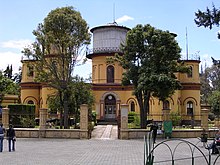Education in Ecuador
This article needs to be updated. (April 2019) |
The Ecuadorian Constitution requires that all children attend school until they achieve a “basic level of education,” which is estimated at nine school years.
The Human Rights Measurement Initiative (HRMI)[1] finds that Ecuador is fulfilling only 83.4% of what it should be fulfilling for the right to education based on the country's level of income.[2] HRMI breaks down the right to education by looking at the rights to both primary education and secondary education. While taking into consideration Ecuador's income level, the nation is achieving 79.6% of what should be possible based on its resources (income) for primary education and 87.3% for secondary education.[3]
Primary and secondary
This article reflects educational realities that, largely, precede the current government which, since 2006, has devoted an increasing percentage of the GDP to education. The article is badly in need of updating since many things have changed in the last 10 years in general in Ecuador but especially in education. Anecdotally, there now appears to be competition to enroll children in publicly funded schools and high schools. Ecuador

In 1996, the net primary enrollment rate was 96.9 percent, and 71.8 percent of children stayed in school until the fifth grade. Primary school attendance rates were unavailable for Ecuador as of 2001.
While enrollment rates indicate a level of commitment to education, they do not always reflect children's participation in school. The cost of primary and secondary education is borne by the government, but families often face significant additional expenses such as fees and transportation costs. In 2000, government spending on education declined, both in real terms and as a proportion of GDP. By 2012, GDP spending had gone from 2.6% to 5.2%.
Tertiary

During the 1998-1999 school year, almost 235,000 students were enrolled in institutions of higher education, or approximately 14% of the population between 18–24 years old.[6] Approximately 80% attend public universities while the other 20% attend private universities.[6] The Central University of Ecuador, National Polytechnic School and the Universidad San Francisco de Quito[7][8] account for more than 60% of enrollments.[9][6] The graduation rate at public universities is rarely more than 15%.[6]
Major Universities in Quito
National Polytechnic School
National Polytechnic School (Spanish: Escuela Politécnica Nacional), also known as EPN, is a public university located in Quito, Ecuador and is known for research and education in the applied science, astronomy, atmospheric physics, engineering and physical sciences. The Geophysics Institute[10][11] monitors over the country's seismic, tectonic and volcanic activity in the continental territory and in the Galápagos Islands.
EPN adopted the polytechnic university model that stresses laboratory instruction in applied science and engineering.
One of the oldest observatories in South America is the Quito Astronomical Observatory. Founded in 1873 and located 12 minutes south of the Equator in Quito, Ecuador. The Quito Astronomical Observatory is the National Observatory of Ecuador and is located in the Historic Center of Quito and is managed by the National Polytechnic School.[12][13]
The Nuclear Science Department at EPN is the only one in Ecuador and has the large infrastructure, related to irradiation facilities like cobalt-60 source and electron beam processing.
USFQ
Universidad San Francisco de Quito, USFQ main campus is located in Cumbayá, outside of Quito, where students use a library, education and research laboratories, classrooms, and seven restaurants. USFQ is the only university in the world that owns a campus in the Galapagos Islands, and a campus in the Yasuni Biosphere Reserve (Tiputini Biodiversity Station), one of Earth's most biodiverse area.[7][8]
Central University of Ecuador
The Central University of Ecuador (Spanish: Universidad Central del Ecuador) is a national university located in Quito, Ecuador. It is the oldest university in Ecuador, established in 1826 and one of the oldest in the Americas. The enrollment is over 10,000 students per year.[14]

Pontificia Universidad Católica del Ecuador
Pontificia Universidad Católica del Ecuador (PUCE) (English:Pontifical Catholic University of Ecuador) is a Pontifical Catholic university located in Quito, Ecuador.[15][16]
2008 Constitution of Ecuador
The 2008 Constitution of Ecuador eliminated tuition in public universities.[17] Starting in 2012, admission to the country's 29 public universities will be based on an aptitude test.[17][18]
See also
References
- ^ "Human Rights Measurement Initiative – The first global initiative to track the human rights performance of countries". humanrightsmeasurement.org. Retrieved 2022-03-17.
- ^ "Ecuador - HRMI Rights Tracker". rightstracker.org. Retrieved 2022-03-17.
- ^ "Ecuador - HRMI Rights Tracker". rightstracker.org. Retrieved 2022-03-17.
- ^ Ministry of Education Information System (SIME) ecuadorconsultas.com
- ^ (SIME) Ministry of Education Information System adictoec.com
- ^ a b c d Rojas 2003, p. 274.
- ^ a b Sobre la USFQ [1] Archived 2012-05-01 at the Wayback Machine.
- ^ a b Universidad San Francisco de Quito @QSTopUniversities [2] Archived 2011-10-11 at the Wayback Machine.
- ^ [3] UNIVERSITIES IN ECUADOR by 2014 University Web Ranking
- ^ "Instituto Geofísico - EPN - Home". igepn.edu.ec.
- ^ https://www.youtube.com/user/institutogeofisico YouTube Channel for the Geophysics Institute at EPN
- ^ Virtual Telescope System, NASA, Scientific research
- ^ The Quito Astronomical Observatory is managed by EPN, official web site
- ^ http://www.uce.edu.ec/ Official web site of Central University of Ecuador
- ^ "Breve Reseña Histórica" (in Spanish). Pontificia Universidad Católica del Ecuador. Retrieved 10 July 2013.
- ^ http://www.puce.edu.ec/ Official web site of Pontificia Universidad Católica del Ecuador (PUCE)
- ^ a b Neuman, William (19 March 2012). "'Garage Universities' Are Bracing for School Reform". The New York Times. p. A7.
- ^ [4] The largest mega-diversity on the planet makes it home in Ecuador, the center of the world. With a privileged climate and the most breathtaking landscapes, the essence of Latin America merged to create a unique and unforgettable destination. Islands, rainforest, Andes and seas, 4 worlds are waiting for you.
Works cited
- Rojas, Carlos (2003). "Education". In Frete-Cibils, Vicente; Giugale, Marcelo M.; López-Cálix, José Roberto (eds.). Ecuador: An Economic and Social Agenda in the New Millennium. World Bank Publications. ISBN 0-8213-5545-7.
External links
- (es) SIME sime.educacion.gob.ec


